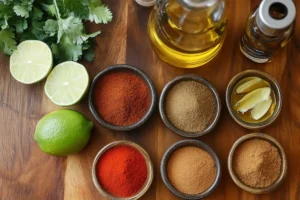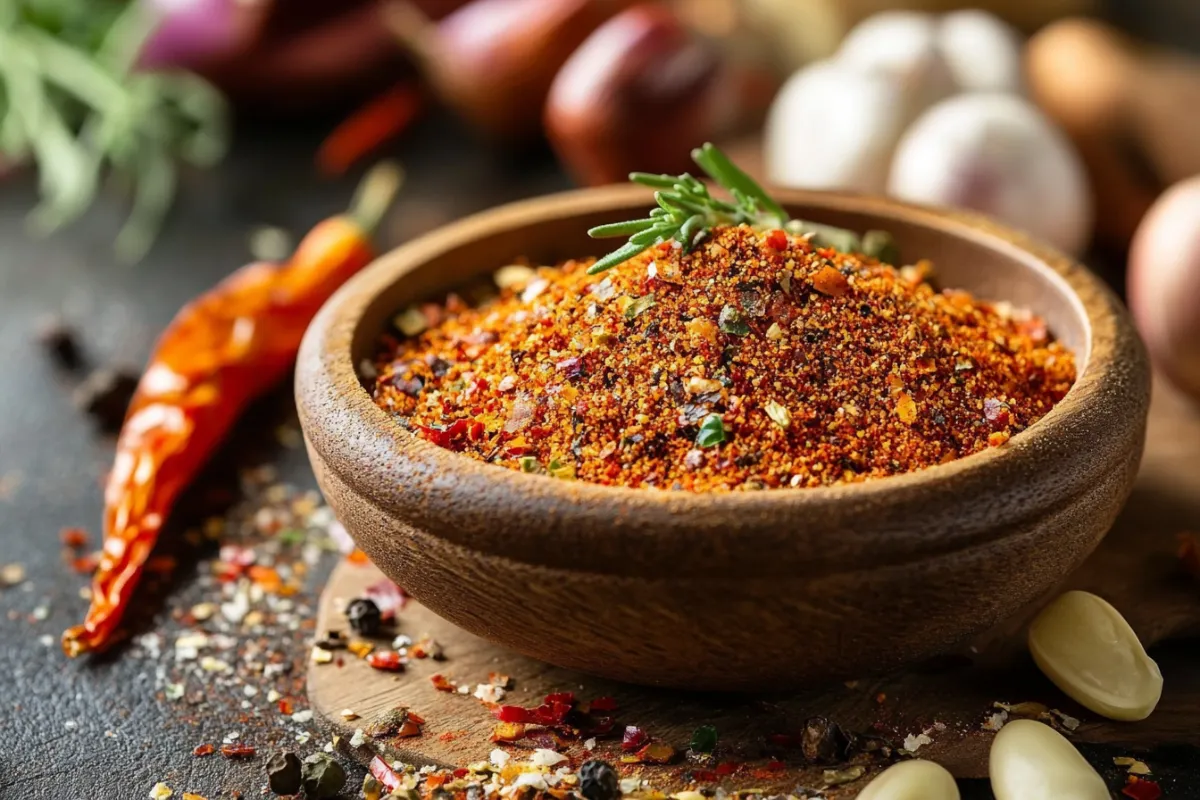Fajita seasoning is the essential spice blend that gives your fajitas their distinctive flavor. Whether you’re grilling up steak, chicken, or veggies, this seasoning provides the perfect balance of spices to make your dish sing. But what exactly is in fajita seasoning?
Making your own fajita spice mix at home allows you to tailor the blend to your taste, giving you more control over the flavors and avoiding unnecessary additives found in store-bought versions. For a straightforward recipe, you can try making your own blend with guidance from The Kitchn – Fajita Seasoning. If you’re interested in understanding how different spices work together, Serious Eats – Spice Blends Guide provides a detailed overview of creating balanced spice mixes.
For those looking to use their seasoning in marinades, check out Fajita Marinade: How to Create the Perfect Mix for Delicious Fajitas, which offers insights into making the most flavorful marinades for your fajitas.
Key Ingredients in Fajita Seasoning
To create an authentic fajita spice blend at home, you’ll need the following key ingredients:

- Chili Powder:
- The base of the seasoning, chili powder provides mild to medium heat and a deep, rich flavor, essential for that classic fajita taste.
- Paprika:
- Paprika adds a bright red color and a mild, slightly sweet flavor. If you prefer a smokier taste, you can use smoked paprika.
- Oregano:
- A staple herb in Mexican cuisine, oregano introduces earthy, slightly bitter notes that enhance the depth of flavor.
- Garlic Powder:
- Garlic powder adds a strong, pungent flavor without the moisture that fresh garlic brings, making it perfect for dry rubs and seasonings.
- Onion Powder:
- This ingredient provides a subtle, sweet onion flavor that blends seamlessly with the other spices.
- Salt:
- Kosher salt is typically used to balance the flavors, but you can adjust the amount based on your preference.
- Optional Ingredients:
- Cumin: Adds warmth and depth to the blend, making it richer.
- Brown Sugar: Adds a hint of sweetness to balance the spice.
- Cayenne Pepper: For those who like it hot, cayenne pepper adds an extra kick.
To see how this spice blend can be turned into a flavorful sauce, refer to What is Fajita Sauce Made Of?, where you can learn about the integration of these spices into a complete sauce.
How to Make Fajita Seasoning at Home
Making this spice blend at home is quick, easy, and allows for customization:

- Small Batch vs. Large Batch:
- Whether you’re making a small batch for a single meal or a large batch to store for later, the process is simple. Multiply the ingredients as needed and store any extra in an airtight container.
- Mixing the Ingredients:
- Combine all the spices in a bowl and mix thoroughly. Using a whisk can help break up any clumps and ensure that everything is evenly distributed.
- Storing the Seasoning:
- Store your blend in a cool, dry place. An airtight container is best for keeping it fresh, and it can last up to six months if stored properly.
Uses for Fajita Seasoning
This seasoning blend is versatile and can be used in a variety of ways:
- As a Rub:
- Use the blend as a dry rub for meats like chicken, beef, or pork before grilling or cooking. It helps create a flavorful crust that locks in the juices.
- As a Marinade:
- Combine the mix with oil and lime juice to make a marinade that not only flavors the meat but also tenderizes it. For tips on how to tenderize meat effectively, visit What is the Best Way to Tenderize Fajita Meat?.
- In Fajita Sauce:
- Add the mix to a sauce for cooking vegetables and meats. This method works great for stovetop fajitas, where everything can be cooked together in a skillet.
Variations of Fajita Seasoning
There are many ways to customize this spice mix to suit your taste:
- Spicy Fajita Seasoning:
- Increase the heat by adding extra chili powder, cayenne pepper, or even a dash of hot sauce for an intense kick.
- Smoky Fajita Seasoning:
- Use smoked paprika or add chipotle powder to introduce a deeper, smoky flavor to the mix.
- Sweet Fajita Seasoning:
- For a touch of sweetness, add brown sugar or honey powder to the blend. This variation pairs well with spicier meats.
Nutritional Information and Serving Suggestions
Nutritional Breakdown
This seasoning blend is low in calories but packed with flavor:
- Calories and Fats:
- A typical serving is low in calories, with most of the content coming from the spices. If you’re watching your sodium intake, consider using a salt substitute or reducing the amount of salt.
- Sugar Content:
- Adding brown sugar or other sweeteners will increase the sugar content slightly, but it remains minimal.
Portion Control
Use this seasoning wisely to enhance flavor without overpowering the dish:
- As a Rub:
- About 1-2 tablespoons of the mix per pound of meat is usually sufficient. Adjust based on your preference for flavor intensity.
- As a Marinade:
- Combine 2-3 tablespoons of the mix with 1/4 cup of oil and 1 tablespoon of lime juice for a flavorful marinade that tenderizes and seasons the meat.
Pairing Suggestions
This spice blend is incredibly versatile and pairs well with a variety of dishes:
- Grilled Meats:
- Use the blend on grilled chicken, steak, or pork to create a smoky, flavorful crust.
- Vegetables:
- Toss your favorite vegetables in the mix before roasting or grilling to add an extra burst of flavor.
- Tacos and Burritos:
- Seasoned meats work perfectly in tacos, burritos, or quesadillas, adding a spicy kick to these dishes.
Tips for Perfecting Fajita Seasoning
To make the best fajita spice blend, keep these tips in mind:

- Balancing Flavors:
- Adjust the spices to your taste. For a milder blend, reduce the chili powder and cayenne. For more flavor, increase the cumin and garlic powder.
- Customizing for Dietary Needs:
- Create low-sodium or gluten-free versions by adjusting the salt and ensuring all spices are gluten-free.
- Experimenting with Spices:
- Don’t be afraid to experiment! Try adding coriander, black pepper, or even a bit of cinnamon for a unique twist.
Common Mistakes to Avoid
Even with a simple recipe like this spice blend, there are a few common mistakes to avoid:
- Overloading on Salt:
- Too much salt can overpower the other flavors. Start with a smaller amount and adjust as needed.
- Skipping the Mixing:
- Make sure the spices are well mixed to avoid clumps and uneven flavor distribution.
- Not Tasting as You Go:
- Taste the blend before using it to ensure it has the right balance of flavors.
FAQs About Fajita Seasoning
Can I use store-bought seasoning?
- Yes, store-bought seasoning is convenient, but making your own allows you to control the ingredients and customize the flavor to your liking.
How long does homemade fajita seasoning last?
- Homemade seasoning can last up to six months if stored in an airtight container in a cool, dry place.
Is fajita seasoning gluten-free?
- Most spices are naturally gluten-free, but it’s always important to check the labels for any potential cross-contamination.
Can I make a salt-free version of fajita seasoning?
- Absolutely! You can omit the salt or use a salt substitute to create a lower-sodium version.
What is the difference between fajita seasoning and taco seasoning?
- Fajita seasoning typically has a milder flavor with a focus on chili powder, paprika, and cumin, while taco seasoning often includes more herbs and has a slightly different spice blend.

